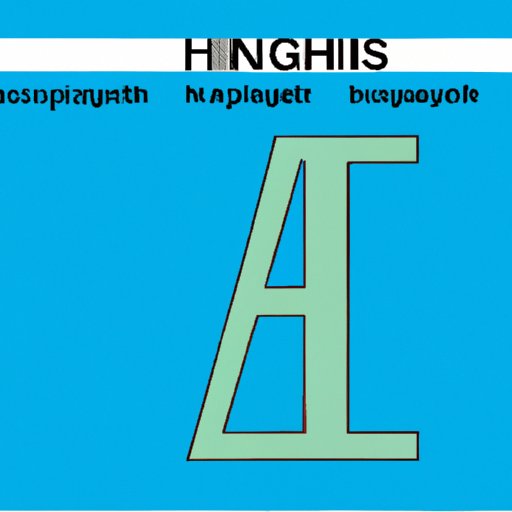
I. Introduction
When it comes to solving geometric problems, one of the most common challenges is finding the hypotenuse of a right triangle. This value, which represents the longest side of the triangle and is opposite the right angle, is essential for a wide range of practical applications. From architecture to engineering and construction, understanding how to find the hypotenuse is crucial for accurate measurements and calculations. This article aims to provide readers with a step-by-step guide to finding the hypotenuse, along with real-world applications, historical context, common mistakes to avoid, and the everyday relevance of this important geometric concept.
II. Step-by-Step Guide
The process of finding the hypotenuse of a right triangle can seem daunting, but with a little guidance, it can be broken down into simple steps. First, identify the two shorter sides of the triangle, known as the legs. Label these sides as ‘a’ and ‘b,’ using whichever one you prefer for each leg.
Next, square each of the leg values, and then add them together. This will give you the sum of the squares of the legs. In mathematical terms, this is expressed as a² + b² = c², where ‘c’ represents the length of the hypotenuse and ‘²’ denotes that the number should be squared.
Once you have the sum of the squares of the legs, take the square root of the answer. This will give you the length of the hypotenuse. Remember to round numbers to the appropriate degree of accuracy, depending on the situation.
It is important to double-check your calculations and make sure that you are using the Pythagorean theorem correctly. This theorem is a fundamental concept in geometry and states that in a right triangle, the sum of the squares of the two shorter sides is equal to the square of the longest side (the hypotenuse).
Using diagrams and visuals can be helpful in illustrating each step and making it easier to understand. There are also many online calculators available to double-check the accuracy of your calculations.
III. Real World Applications
The practical applications of finding the hypotenuse are many and varied. Architects and engineers use this concept to calculate distances, angles, and diagonal measurements in buildings and structures. The construction industry uses it to ensure that structures are stable and built to code. Surveyors and cartographers use it to create maps and measure distances accurately. Even in everyday life, understanding how to find the hypotenuse can be useful for solving real-world problems, such as calculating the diagonal measurement of a TV or determining the length of a ladder needed to reach a certain height.
Real-life examples can help to make the concept of finding the hypotenuse more tangible and relatable. For instance, a building contractor may need to determine the diagonal measurement of a room to ensure that they order carpeting or other materials in the appropriate quantity. If they don’t understand how to find the hypotenuse, they could end up with costly mistakes and wasted materials.
IV. Historical Context
The origins of the Pythagorean theorem, which is the basis for finding the hypotenuse, date back to ancient Greece and the mathematician Pythagoras. However, the concept of finding the hypotenuse has evolved over time, with new approaches and discoveries building on the original theorem. Understanding the history of the concept can help to put it in context and deepen your appreciation for its significance. For instance, did you know that the ancient Greeks believed that geometry was a sacred art and believed that perfect shapes represented the divine?
V. Common Mistakes to Avoid
Even with a solid understanding of the process, mistakes can easily happen when trying to find the hypotenuse. A common error is to mix up the values of the legs, leading to an inaccurate result. Another common mistake is to misapply the Pythagorean theorem, either by adding or subtracting the squares of the legs instead of adding them. It is important to pay close attention to the formula and double-check your calculations to avoid these types of mistakes.
Using examples can be a useful way to illustrate these mistakes and how they can affect the accuracy of calculations. For instance, calculating the hypotenuse of a triangle with legs of 3 and 4 instead of 4 and 5 could give you an entirely different result.
VI. Common Applications in Daily Life
Understanding the hypotenuse can be useful in a variety of everyday scenarios. For example, if you need to hang a picture on a wall and want to estimate the distance from the floor to the hook, you can use the Pythagorean theorem to calculate the distance and make sure that the picture is hung level. If you are building a deck and need to determine the diagonal length of the deck boards, you can use the hypotenuse to make sure that you order the right quantity of materials.
Using relatable examples can help to show readers the practical relevance of the hypotenuse. For instance, if you are planning a road trip and want to estimate the distance between two cities on a map, understanding the hypotenuse can help you make a more accurate estimate of the time it will take to travel.
VII. Conclusion
Finding the hypotenuse of a right triangle may seem like a daunting task, but with a little guidance, it can be broken down into simple steps. Understanding this concept is critical for a wide range of practical applications in fields such as architecture, construction, and engineering. Real-life examples, historical context, and common mistakes to avoid can all help deepen your understanding of this essential geometric concept. By applying what you’ve learned to real-world scenarios, you can make more accurate calculations and solve problems more effectively.




